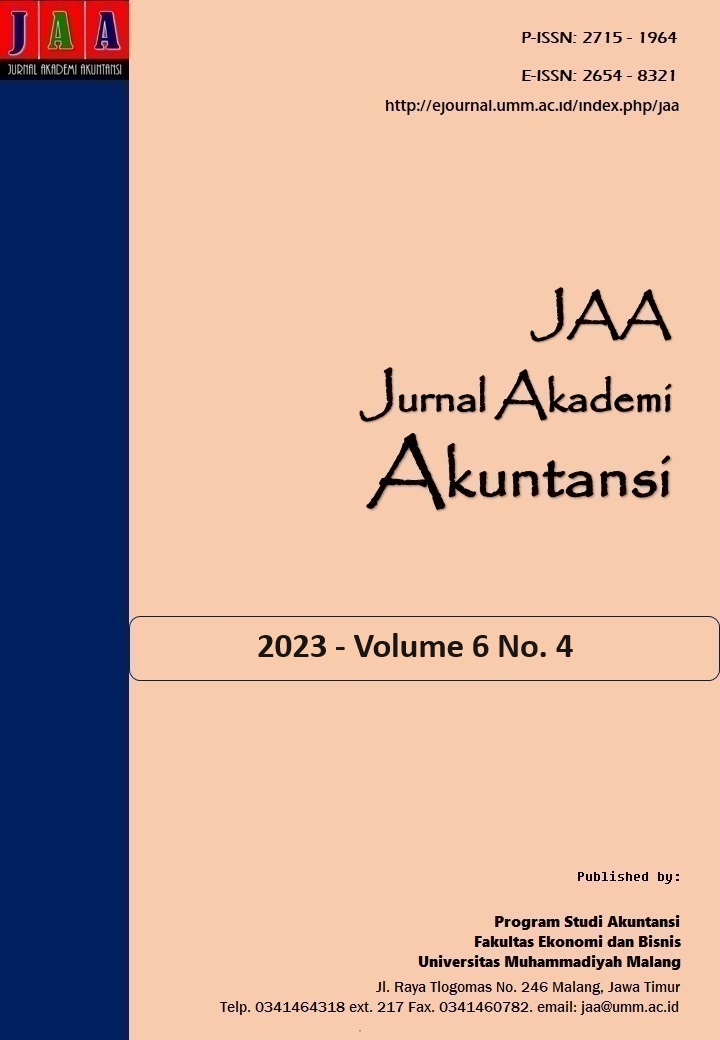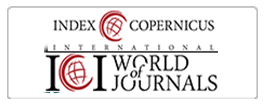Kecurangan Laporan Keuangan Dalam Perspektif Fraud Hexagon
DOI:
https://doi.org/10.22219/jaa.v6i4.30208Keywords:
Effective Monitoring, External Audit Quality, Fraud Hexagon, Transport and LogisticAbstract
Purpose: Financial statement fraud is a fraudulent act that causes the largest average loss of Rp11.01 billion per case (ACFE Indonesia, 2020). The purpose of this study is to investigate the effect of financial target, financial stability, external pressure, changes in directors, the number of CEO photos and government projects on financial statement fraud. Effective monitoring and external audit quality are the moderating variables in this research. The moderating variable is used to determine whether it can weaken the influence of independent variables on dependent variables.
Methodology/approach: This study use 110 secondary data from transportation and logistics companies listed on the Indonesia Stock Exchange for the period 2017-2021. The method used is moderating regression analysis. This research use SPSS 26 as data processing tools.
Findings: The results show that financial target have a significant effect on financial statement fraud. The study also indicate that effective monitoring and external audit quality as moderating variables play important roles in decreasing the influence of independent variables on financial statement fraud.
Practical and Theoretical Contribution/Originality: This research contributes by using effective monitoring and external audit quality as moderating variable, thereby providing a broader insight.
Research Limitation: The limitation of this research is the use of a relatively small sample size, which makes the result of this study can not be generalized.
Downloads
References
Abdurrahim, A. (2015). MENDETEKSI EARNINGS MANAGEMENT. Jurnal Akuntansi & Investasi, 1(2), 104–111.
ACFE. (2023). Occupational Fraud 2022: A Report To The Nations.
ACFE Indonesia. (2020). SURVEI FRAUD INDONESIA.
Achmad, T., Ghozali, I., & Pamungkas, I. D. (2022). Hexagon Fraud: Detection of Fraudulent Financial Reporting in State-Owned Enterprises Indonesia. Economies, 10(1). https://doi.org/10.3390/economies10010013
Apriliana, S., & Agustina, L. (2017). The Analysis of Fraudulent Financial Reporting Determinant through Fraud Pentagon Approach. JDA Jurnal Dinamika Akuntansi, 9(2), 154–165. https://doi.org/10.15294/jda.v9i2.4036
Aviantara, R. (2019). The BIG 4 Role in Moderating the Detection of Fraud Pentagon Against Fraudulent Financial Reports (Study on Indonesian Public Sector Government Companies). International Journal of Sciences: Basic and Applied Research, Volume 48, 94–107. http://gssrr.org/index.php?journal=JournalOfBasicAndApplied
Aviantara, R. (2021). The Association Between Fraud Hexagon and Government’s Fraudulent Financial Report. Asia Pacific Fraud Journal, 6(1), 26. https://doi.org/10.21532/apfjournal.v6i1.192
Beasley, M. S. (1996). An Empirical Analysis of the Relation between the Board of Director Composition and Financial Statement Fraud. In Source: The Accounting Review (Vol. 71, Issue 4).
Damayani, F., Wahyudi, T., & Yuniatie, E. (2017). PENGARUH FRAUD PENTAGON TERHADAP KECURANGAN LAPORAN KEUANGAN PADA PERUSAHAAN INFRASTRUKTUR YANGTERDAFTAR DI BURSA EFEK INDONESIATAHUN 2014 – 2016. Akuntabilitas: Jurnal Penelitian Dan Pengembangan Akuntansi, Volume 11(Nomor 2).
Deangelo, L. E. (1981). AUDITOR SIZE AND AUDIT QUALITY. In Journal of Accounting and Economics (Vol. 3). North-Holland Publishing Company.
Dechow, P. M., Sloan, R. G., & Sweeney, A. P. (1996). Causes and consequences of earnings manipulation: An analysis of firms subject to enforcement actions by the SEC. Contemporary Accounting Research, 13(1), 1–36. https://doi.org/10.1111/j.1911-3846.1996.tb00489.x
Evana, E., Metalia, M., Mirfazli, E., Georgieva, D. V., & Sastrodiharjo, I. (2019). Business Ethics in Providing Financial Statements: The Testing of Fraud Pentagon Theory on the Manufacturing Sector in Indonesia. Business Ethics and Leadership, Volume 3(Issue 3).
Handoko, B. L., & Salim, A. S. J. (2022). Fraud Detection Using Fraud Hexagon Model in Top Index Shares of KOMPAS 100. 2022 12th International Workshop on Computer Science and Engineering, WCSE 2022, 112–116. https://doi.org/10.18178/wcse.2022.06.017
Handoko, B. L., & Tandean, D. (2021). An Analysis of Fraud Hexagon in Detecting Financial Statement Fraud (Empirical Study of Listed Banking Companies on Indonesia Stock Exchange for Period 2017-2019). ACM International Conference Proceeding Series, 93–100. https://doi.org/10.1145/3457640.3457657
Hartadi, B. (2022). Pengaruh Fraud Hexagon terhadap Fraudulent Financial Statements pada Perusahaan Badan Usaha Milik Negara Indonesia yang Terdaftar di BEI pada Tahun 2018-2021. Jurnal Pendidikan Tambusai, Volume 6(Nomor 2).
Janah, N., Rachmawati, L., & Widaninggar, N. (2022). The Effect of Fraud Hexagon Model on Fraud Financial Statements in Companies in the Financial Sector. Assets : Jurnal Ilmiah Ilmu Akuntansi, Keuangan Dan Pajak, 6(2), 64–76. https://doi.org/10.30741/assets.v6i2.844
Koomson, T. A. A., Owusu, G. M. Y., Bekoe, R. A., & Oquaye, M. (2020). Determinants of asset misappropriation at the workplace: the moderating role of perceived strength of internal controls. Journal of Financial Crime, 27(4), 1191–1211. https://doi.org/10.1108/JFC-04-2020-0067
Marks, J. (2012). The Mind Behind The Fraudsters Crime: Key Behavioral and Environmental Elements.
Nizarudin, A., Nugroho, A. A., Agustina, D., & Anggita, W. (2023). Analisis Komparatif Teori Penipuan Crowe Pentagon On Pelaporan Keuangan Palsu. Jurnal Akuntansi, 27(1), 19–37. https://doi.org/10.24912/jm.v27i1.1104
Pamungkas, I. D., Ghozali, I., Achmad, T., Khaddafi, M., & Hidayah, R. (2018). Corporate Governance Mechanisms in Preventing Accounting Fraud: A Study of Fraud Pentagon Model. Journal of Applied Economic Sciences, Volume XIII(Spring 2), 549–560.
Pamungkas, I. D., & Utomo, S. D. (2018). Fraudulent financial reporting: An application of fraud pentagon theory to association of southeast Asian nations corporate governance scorecard. Journal of Advanced Research in Law and Economics, 9(5), 1729–1737. https://doi.org/10.14505/jarle.v9.5(35).26
Rahayu, D. (2020). ANALISIS PENGARUH FRAUD TRIANGLE TERHADAP FRAUDULENT FINANCIAL REPORTING DENGAN KUALITAS AUDIT SEBAGAI VARIABEL MODERASI. Prosiding Seminar Nasional Pakar Ke 3.
Sagala, S. G., & Siagian, V. (2021). Pengaruh Fraud Hexagon Model Terhadap Fraudulent Laporan Keuangan pada Perusahaan Sub Sektor Makanan dan Minuman yang Terdaftar di BEI Tahun 2016-2019. Jurnal Akuntansi, 13(2), 245–259.
Sari, M. P., Mahardika, E., Suryandari, D., & Raharja, S. (2022). The audit committee as moderating the effect of hexagon’s fraud on fraudulent financial statements in mining companies listed on the Indonesia stock exchange. Cogent Business and Management, 9(1). https://doi.org/10.1080/23311975.2022.2150118
Sari, M. P., Pramasheilla, N., Fachrurrozie, Suryarini, T., Pamungkas, I. D. (2020). Analysis of Fraudulent Financial Reporting W ith the Ro le of KAP Big Four as a Moderation Variable: Crowe's Fraud's Pentagon Theory. International Journal of Financial Research, 11(5).
Sawaka K., I. G. N. H., & Ramantha, I. W. (2020). Fraud pentagon theory in detecting financial perception of financial reporting with good corporate governance as moderator variable. International Research Journal of Management, IT and Social Sciences. https://doi.org/10.21744/irjmis.v7n1.824
Sihombing, K. S., & Rahardjo, S. N. (2014). ANALISIS FRAUD DIAMOND DALAM MENDETEKSI FINANCIAL STATEMENT FRAUD : STUDI EMPIRIS PADA PERUSAHAAN MANUFAKTUR YANG TERDAFTAR DI BURSA EFEK INDONESIA (BEI) TAHUN 2010-2012. DIPONEGORO JOURNAL OF ACCOUNTING, 03, 1–12.
Skousen, C. J., Smith, K. R., & Wright, C. J. (2009). Detecting and predicting financial statement fraud: The effectiveness of the fraud triangle and SAS No. 99. Advances in Financial Economics, 13, 53–81. https://doi.org/10.1108/S1569-3732(2009)0000013005
Surjaatmaja, L. (2018). Detecting Fraudulent Financial Statement Using Fraud Triangle: Capability as Moderating Variable. KnE Social Sciences, 3(10), 945. https://doi.org/10.18502/kss.v3i10.3184
Suyono, E. (2017, September 20). BEBAGAI MODEL PENGUKURAN EARNINGS MANAGEMENT: MANA YANG PALING AKURAT. SUSTAINABLE COMPETITIVE ADVANTAGE-7 (SCA-7) FEB UNSOED.
Vousinas, G. L. (2019). Advancing theory of fraud: the S.C.O.R.E. model. Journal of Financial Crime, 26(1), 372–381. https://doi.org/10.1108/JFC-12-2017-0128
Wolfe, D. T., & Hermanson, D. R. (2004). The Fraud Diamond: Considering the Four Elements of Fraud.
Yulianti, Pratami, S. R., Widowati, Y. S., & Prapti, L. (2019). Influence Of Fraud Pentagon Toward Fraudulent Financial Reporting In Indonesia An Empirical Study On Financial Sector Listed In Indonesian Stock Exchange. INTERNATIONAL JOURNAL OF SCIENTIFIC & TECHNOLOGY RESEARCH, 8, 8.
Downloads
Published
Issue
Section
License
Copyright (c) 2024 Joga Widyarwo Aditantra, Anis Chariri

This work is licensed under a Creative Commons Attribution-NonCommercial-ShareAlike 4.0 International License.
Jurnal Akademi Akuntansi is licensed under a Creative Commons Attribution-NonCommercial-ShareAlike 4.0 International License.
Authors who publish with this journal agree to the following terms:
- Authors retain copyright and grant the journal right of first publication with the work simultaneously licensed under a Creative Commons Attribution-NonCommercial-ShareAlike 4.0 International License that allows others to share the work with an acknowledgment of the work's authorship and initial publication in this journal.
- Authors are able to enter into separate, additional contractual arrangements for the non-exclusive distribution of the journal's published version of the work (e.g., post it to an institutional repository or publish it in a book), with an acknowledgment of its initial publication in this journal.
- Authors are permitted and encouraged to post their work online (e.g., in institutional repositories or on their website) prior to and during the submission process, as it can lead to productive exchanges, as well as earlier and greater citation of published work (See The Effect of Open Access).
Jurnal Akademi Akuntansi dilisensikan di bawah lisensi Creative Commons Attribution-NonCommercial-ShareAlike 4.0 International.
Penulis yang menerbitkan artikel di jurnal ini menyetujui ketentuan berikut:
- Penulis mempertahankan hak cipta dan memberikan hak jurnal atas publikasi pertama dengan karya yang secara serentak dilisensikan di bawah Lisensi Pengaitan Creative Commons yang memungkinkan orang lain untuk berbagi karya dengan pengakuan atas karya penulis dan publikasi awal dalam jurnal ini.
- Penulis dapat masuk ke dalam pengaturan kontrak tambahan yang terpisah untuk distribusi non-eksklusif versi karya jurnal yang diterbitkan (misalnya, mempostingnya ke repositori institusional atau mempublikasikannya dalam sebuah buku), dengan pengakuan publikasi awalnya di jurnal ini.
- Penulis diizinkan dan didorong untuk memposting pekerjaan mereka secara online (misalnya, di repositori institusional atau di situs web mereka) sebelum dan selama proses pengajuan, karena dapat mengarah pada pertukaran produktif, serta kutipan pekerjaan sebelumnya dan yang lebih besar (Lihat Pengaruh Akses Terbuka).
























